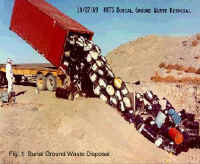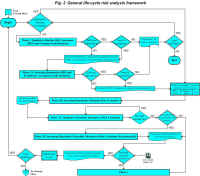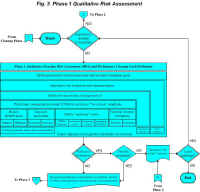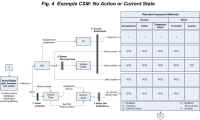Overview: Before 1970, hundreds of thousands of cubic meters of wastes contaminated with transuranic (TRU) constituents as well as low-level and mixed low-level wastes generated from nuclear materials production were buried at various sites across the U.S. Department of Energy (DOE) Complex. As illustrated in Fig. 1, most of these wastes were buried in unlined pits and trenches and covered with soil creating the potential for contaminant migration and exposure with concomitant safety and health concerns. Not only is the buried waste inventory large but the waste types are highly variable and often inter-mixed with hazardous wastes making their retrieval and disposal highly problematic. Many of the TRU constituents (e.g., Pu-239 and Np-237) buried at these sites possess very long half-lives and some are considered among the most dangerous substances known.
Apparent inconsistency in regulatory approach and agreements, including historic DOE management, concerning disposal alternatives provides neither a consistent basis for site restoration nor transparency to stakeholders. To provide a common basis as input to a risk-informed decision-making process, a framework will be formulated for the consistent technical evaluation of the life-cycle risks and risk trade-offs associated with buried waste disposition and site remediation. Use of this framework will differ from existing approaches by providing a basis for evaluating all relevant risk trade-offs involving the general public and workers in a consistent and transparent manner.
Approach: The goal of this research is the development of a general life-cycle risk analysis framework for assessing the risks and risk trade-offs associated with disposition of buried wastes generated from past nuclear material production and currently managed by the U.S. Department of Energy (DOE). To achieve this goal, an overall conceptual framework (Fig. 2) will be developed that outlines the general process for the rational and transparent comparison of the risks and risk trade-offs involved with either managing buried wastes in-place or retrieving these wastes for disposal elsewhere. A more detailed example of one of the risk assessment phases is provided in Fig. 3. A methodology (including instructions, conceptual models, diagrams, metrics, etc.) will be defined that allow the framework to be applied to DOE buried waste sites. One essential feature, the conceptual site model (Fig. 4), is a written or pictorial representation of an environmental system and the biological, physical, and chemical processes that determine the transport of contaminants from sources through environmental media to environmental receptors ... [1] The resulting framework will be applied to selected prototype sites to evaluate the research hypothesis that managing buried wastes in-place can result in lower life-cycle risks than retrieving the wastes for subsequent treatment and disposal elsewhere.
 |
 |
 |
 |
|
Fig. 1
|
Fig. 2
|
Fig. 3
|
Fig. 4
|
|
Burial Ground Waste Disposal [2]
|
Overall Framework
|
Phase 1 Risk Assessment
|
Example CSM [3]
|
Example Applications: A draft version of the proposed risk assessment framework and methodology was applied to two areas within the DOE Idaho Site: 1) the Calcined Bin Sets [4] containing high-level waste and 2) the Subsurface Disposal Area (SDA) [3] where wastes contaminated with radioactive and hazardous materials were buried in pits, trenches, and soil vaults between 1954 and 1970. These reports [3,4] were presented to the Idaho Site Citizens Advisory Board (CAB) and provided the basis for two CAB recommendations (Numbers 123 and 124) made to the site.
Literature Cited:
- ASTM, Standard Guide for Developing Conceptual Site Models for Contaminated Sites. ASTM Standard E 1689-95, 8 p.
- Lenhard, R. J., A. K. Yonk, P. M. Wright, and J. D. Herzog The Idaho National Engineering and Environmental Laboratory site; an overview of site history and soil and groundwater contamination issues (in Understanding subsurface flow and transport processes at the Idaho National Engineering & Environmental Laboratory (INEEL) site) Vadose Zone Journal (February 2004), 3(1):1-5.
- Brown, K. G., Switzer, C., Kosson, D. S., Clarke, J. H., Parker, F. L., Powers, C. W., Mayer, H. J., and Greenberg, M. (2005). "Preliminary Risk Evaluation of Options for Buried Waste Disposition at the Idaho Site." Consortium for Risk Evaluation with Stakeholder Participation (CRESP), Piscataway, NJ USA. Full text article available at www.cresp.org.
- Switzer, C., Brown, K. G., Kosson, D. S., Clarke, J. H., Parker, F. L., Powers, C. W., Mayer, H. J., and Greenberg, M. (2005). "Preliminary Risk Evaluation of Calcined High-Level Waste Disposition at the Idaho Site." Consortium for Risk Evaluation with Stakeholder Participation (CRESP), Piscataway, NJ USA. Full text article available at www.cresp.org.